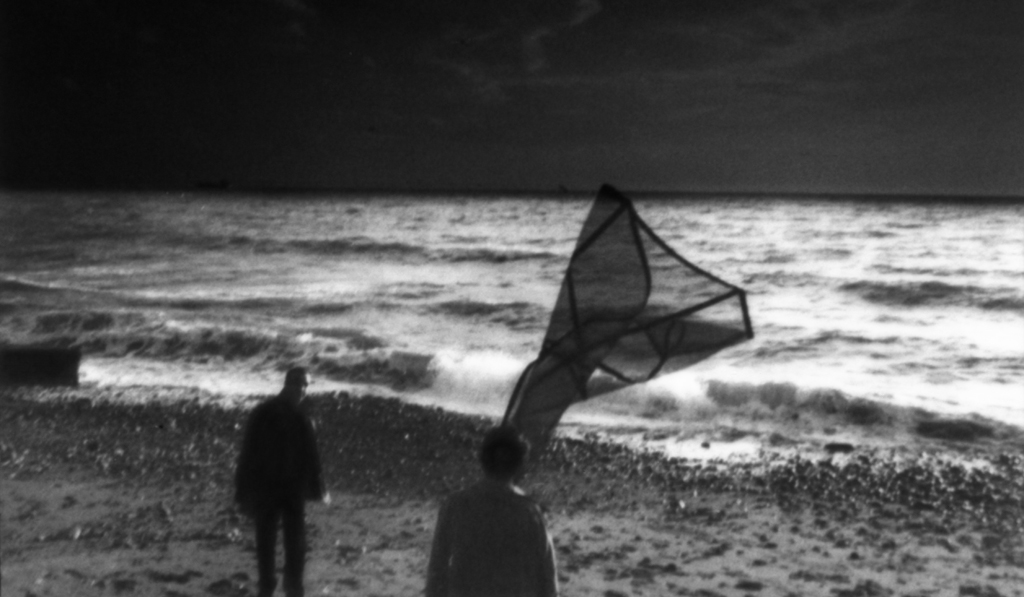We discovered the work of photographer Corinne Mercadier through the multidisciplinary exhibition Comme une histoire… Le Havre (Like a Story… The Havre, ed.) at the MuMA. The artist displayed there her Carré Lunaire (Lunar Square, ed.), a tryptic revealing her timeless and silent universe. If you cannot go to the Museum of Modern Art, get to know Corinne through her soft and calming words
Fisheye: How did you discover photography?
Corinne Mercadier : I started during the 80s with a Polaroid SX-70. At the time, I was mostly drawing and painting and I was using my Polaroid to take visual notes.
Could you talk about your series Longue Distance ? (Long distance, ed.)
I created the series between 2005 and 2007. It is the sequel of another series Une fois et pas plus (No more than once), which was my first attempt at working on the outside space as a theatrical space. I like creating settings, characters, costumes. Long distance goes further into this reflection by adding the cinematographic influence. This is where my choice of adding this modern 16 :9 framing format to the black and white comes from. At the time, this was the first time I used it in my work. The format is a way of highlighting form, lines of force, lighting and structure. My fascination for the cinema and drawing could also explain this choice. My pictures may remind you of charcoal sketches.
What role does light play in your pictures ?
I use light in photography the way it is used in theatre: strong and temporary. Coming from the sky, it shines upon the most important scene, casting away all the shadows surrounding it. Through the association of light with shadow – which, to me, are indivisible – objects and characters appear and disappear. Light and shadow both blur reality.

Could you describe your creative process ?
I have a specific method. Until 2008 (The year when the Polaroid SX-70 stopped being produced) I took pictures and then printed them on colored or black and white paper. They were pictures which were first taken with a Leica silver. The process created a sort of depth, and an atmosphere full of contrast and intensity. The specific texture of the Polaroid fitted my desire to create pictures closer to dreams than to reality.
Is photography a way for you to tell stories ?
It is indeed a way of narrating. It is as if we had found the photogram of a lost film: there are still traces of stories left in my photographies. What they tell is not logical, but remind you of a memory, a dreamlike state. I often wandered if video would be a more appropriate medium for what I am trying to create. But I’ve always come back to the stillness of the image, isolated, because they are inhabited by fragments of tales that I don’t want to own nor interpret.
What are your favourite subjects ?
The space as a stage, chance, mystery, questions we ask ourselves, presence, points of view that influence people’s visions of the world, photography as a metaphor of the unintended.
What does the triptych represent in your work ?
There are only two triptychs in the Long distance series : Carré Lunaire (Lunar Square, ed.) and L’Or (Gold, ed.), and both are very different. L’Or is composed of three different perspectives while Carré Lunaire is made of three successive moments. The triptych creates a development in sequences : if you throw an object in the air, for example, every picture is a different variation, and only a few are chosen for their ability to capture a unique moment, a predictable strangeness.

Could you describe Carré Lunaire ?
It is composed of three pictures. Carré Lunaire tells a story from the left to the right. The left one gave her name to the whole triptych. The characters are all linked by a virtual square on the ground. It is lunar because the atmosphere take us far away from reality, even though we can recognise the beach. In the other two pictures, the object thrown – first folded, that unfolded – seems to touch the man looking away without him realising it. This is – amongst other interpretations – a metaphore symbolising blind destiny. With the sky clearing out on the right, the three photos become three temporal steps trapped in a same sequence.
How did you chose those places ?
In the Long Distance series, I chose landscapes where the horizon took an important place and where the ground was flat. It was a sort of stage, whose background was defined by the horizon and the sides by my frame. Beaches, swimming pools… choosing has a true impact because it defines a limited space which can create an identity to your series, by repeating itself over and over again, from one picture to another.
Why did you chose to present Carré Lunaire at Le Havre ?
Many pictures were shot in front of the horizon, and Le Havre’s beach fitted my projects really well. This triptych is a good sample of my work, portraying the strong contrasts, the mystery which surrounds actions one cannot describe with certainty, and the setting.


© Corinne Mercadier, Galerie Les filles du calvaire









